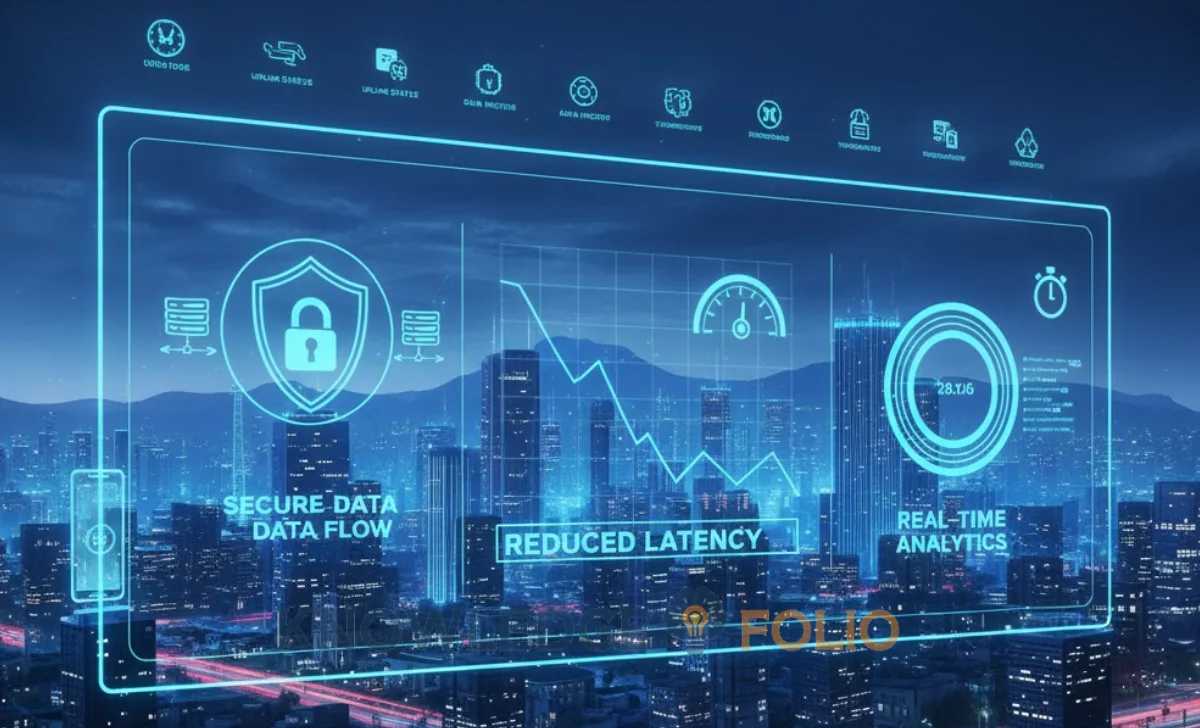Edge computing and 6G are set to transform how devices, data, and infrastructure connect. Together, they enable real-time intelligence and ultra-fast performance for industries worldwide. This article explains how the two technologies intersect and what organizations can do today to prepare for a more connected tomorrow.
Edge computing processes data near its source rather than sending it to distant data centers. 6G networks aim to deliver one terabyte per second with latency under one microsecond — 1,000 times faster than 5G.
When combined, these technologies provide fast response times across diverse networks while managing resources like storage and computation in near real-time. This pairing will power autonomous vehicles, remote surgery, smart factories, and immersive digital experiences that current networks cannot support.
What Is Edge Computing?
1. Definition and Basic Concept
Edge computing brings data processing closer to where information originates. Instead of sending every piece of data to a central cloud server hundreds of miles away, edge computing handles critical tasks locally — at or near the device creating the data.
Think of a security camera system. Traditional cloud computing sends all video footage to a remote data center for analysis. Edge computing processes that footage right at the camera or nearby server, identifying threats instantly without waiting for a round trip to the cloud.
This approach reduces network strain and improves efficiency, particularly for applications requiring split-second decisions.
2. How It Differs from Cloud Computing
Cloud computing centralizes resources in massive data centers. You upload data, the cloud processes it, then sends results back. This works well for tasks without time pressure — storing photos, running monthly reports, or managing email.
Edge computing flips this model. Processing happens at distributed points across the network. Resources are decentralized and positioned near devices or sensors producing the data.
The difference matters most for time-sensitive applications. Cloud computing introduces delays as data travels back and forth. Edge computing eliminates most of that travel time.
Both approaches have their place. Cloud handles complex computations requiring massive power. Edge manages real-time decisions needing immediate responses. The smartest systems use both, processing urgent tasks at the edge while offloading heavy analysis to the cloud.
How 6G Will Redefine Connectivity

1. Key Features of 6G Networks
6G networks will deliver data speeds up to one terabit per second with latency dropping to microseconds — performance levels that seem almost impossible today. These networks will support 10 million devices per square kilometer, compared to 5G’s 1 million.
The technology will use ultra-high radio frequencies to carry more data at faster speeds, with built-in AI and machine learning capabilities. This native intelligence allows networks to adapt automatically to changing conditions.
Commercial deployment remains years away. Research programs in Finland, South Korea, China, and Japan are developing 6G technologies, but most experts expect widespread availability around 2030.
2. Why Speed Alone Isn’t Enough
Raw speed grabs headlines, but 6G’s real value lies in consistency and reliability. The ability to provide high-speed connectivity with predictably low latency and low jitter rates matters more than peak speeds for mission-critical applications.
A self-driving car doesn’t just need fast data — it needs guaranteed response times. System reliability improves through signal density, efficient error correction, and self-healing abilities.
6G will feature intelligence everywhere through a pervasive AI native architecture, distributed data infrastructure, and autonomous operations. Networks will sense their environment, not just transmit data through it.
This shift from pure speed to intelligent, reliable connectivity opens doors for applications where failure isn’t an option — remote surgery, industrial robotics, and autonomous transportation.
The Intersection of Edge Computing and 6G
1. Why They Complement Each Other
Edge computing needs fast, reliable networks. 6G needs distributed intelligence to handle billions of devices. Each technology solves the other’s biggest challenge.
Edge computing provides cloud-computing capabilities within the radio access network closer to end users. 6G makes this possible at unprecedented scale. While edge computing handles real-time, low-latency processing at the network edge, 6G provides the centralized power needed for complex computations.
The combination creates a continuum. Some processing happens on devices themselves. More complex tasks move to nearby edge servers. The heaviest work still goes to cloud data centers. This approach requires effective coordination to dynamically utilize resources in near real-time within a distributed computing environment.
Without edge computing, 6G’s speed gets wasted sending data back and forth to distant clouds. Without 6G’s capacity, edge computing can’t scale to handle billions of connected devices.
2. Real-World Use Cases and Industries
Manufacturing leads adoption. Thousands of sensors synchronize seamlessly across 6G-enabled factory floors, with machines anticipating material flow changes and adjusting in real time. Edge AI processes sensor data locally, catching defects before they become problems.
Healthcare applications show tremendous promise. Wearable devices continuously monitor patients and alert clinicians to subtle trends, with actions occurring through local collaboration via edge AI rather than sending raw data to the cloud. Remote surgery becomes feasible with robotic systems guided by AI algorithms operating over ultra-low latency 6G connections.
Autonomous vehicles depend on this technology stack. Edge intelligence with 6G offers ultra-reliability and ultra-low latency needed for mission-critical applications where even a millisecond of delay isn’t tolerable.
Smart cities gain new capabilities. Traffic systems, emergency services, and utility management all benefit from processing data locally while coordinating across the broader network.
Business Implications and Opportunities
1. Benefits for Enterprises

Companies adopting edge computing and 6G gain competitive advantages across multiple dimensions. Response times drop from milliseconds to microseconds, enabling real-time applications that weren’t previously possible.
Bandwidth costs decrease when you process data locally instead of constantly shuttling it to distant data centers. Privacy and security improve because sensitive information stays closer to its source, reducing exposure during transmission.
Edge computing integrates AI capabilities to process data closer to IoT devices, reducing latency and improving efficiency. This means smarter decisions happen faster, without waiting for cloud analysis.
Early adopters can develop new services and revenue streams. Companies that understand how to deploy edge intelligence at scale will have advantages as 6G networks roll out.
2. Challenges and Considerations
The path forward includes significant obstacles. Managing millions of autonomous edge nodes requires new orchestration models, with security becoming paramount. How do you trust data from devices that are mobile and temporary?
Energy efficiency presents another concern, as the density that makes 6G powerful could also make it energy-hungry if not carefully designed. Operating thousands of edge servers costs money and draws power.
A recent analysis highlighted reality checks for the industry. Mobile network operators have realized that edge computing is neither a viable service to deploy nor a compelling revenue opportunity, with operators increasingly centralizing their computing needs rather than distributing them.
Technical complexity increases dramatically. Staff need training across networking, computing, and AI. Integration between new 6G equipment and existing infrastructure takes careful planning. Spectrum allocation, regulatory policies, and international standards remain works in progress.
How to Prepare for the 6G + Edge Era
1. Steps to Future-Proof Your Infrastructure
Start by auditing your current network architecture. Identify applications that would benefit most from reduced latency — real-time analytics, video processing, or IoT device management.
Invest in modular systems that accept software upgrades rather than requiring complete hardware replacement. Platforms that combine computing and radio functions can be upgraded through software instead of full hardware refresh cycles.
Build expertise now. Teams trained to manage radios will also need to manage AI workloads, requiring new skill sets. Cross-train staff in both networking and computing technologies.
Test edge computing with your existing 5G or 4G infrastructure. You don’t need to wait for 6G to start learning how distributed computing works. Many lessons from 5G edge deployments will apply to 6G systems.
Review your data governance policies. Data rules and controls for AI workloads that run outside the main data center need clear definition before you scale up edge deployments.
2. Strategic Partnerships and Pilot Projects
Industry collaborations are accelerating development. NVIDIA and Nokia recently partnered to run AI workloads inside radio access networks, with NVIDIA planning to invest $1 billion into Nokia. These partnerships show how chip makers, network equipment vendors, and service providers must work together.
Look for vendors offering end-to-end solutions rather than trying to integrate components yourself. Systems that combine computing and networking in unified platforms reduce complexity.
Start small with pilot projects. Choose one use case — perhaps predictive maintenance in manufacturing or real-time inventory tracking — and prove the concept before scaling up. Measure actual improvements in latency, bandwidth usage, and processing speed.
Join industry consortia and standards bodies. The University of Oulu in Finland has launched the 6Genesis research project, while South Korea’s Electronics and Telecommunications Research Institute conducts research on terahertz frequencies. Participating in these efforts helps shape standards and keeps you informed about development timelines.
Building the Connected Future
Edge computing and 6G represent the next major shift in how we connect and process information. The combination enables applications that seemed like science fiction just years ago — from autonomous vehicles to remote surgery to truly intelligent cities.
The technology won’t arrive overnight. Expect gradual rollouts through the late 2020s, with widespread deployment in the 2030s. But preparation should start now. Organizations that build edge computing expertise with current networks, train staff on distributed systems, and develop partnerships with technology vendors will be positioned to take full advantage when 6G arrives.
The future belongs to organizations that can process information where it’s created, make decisions in microseconds, and coordinate across billions of devices. Edge computing and 6G make that future possible.
Conclusions
Edge computing and 6G together mark a major turning point in global digital connectivity. By processing data closer to its source and combining it with ultra-fast, intelligent networks, organizations can achieve unprecedented levels of speed, reliability, and automation. This powerful pairing enables real-time insights, seamless communication between billions of devices, and smarter decision-making across industries — from healthcare and manufacturing to transportation and urban infrastructure.
Businesses that start exploring edge deployments, developing cross-functional expertise, and forming technology partnerships today will gain a decisive advantage as 6G networks mature. The transformation won’t happen overnight, but those who prepare early will shape the connected, intelligent systems that define the next era of innovation. In a world where milliseconds matter, success will belong to companies ready to act — at the edge, in real time, and ahead of the curve.
FAQs
What is the main difference between edge computing and cloud computing?
Cloud computing processes data in centralized data centers, while edge computing handles tasks locally near where data originates. Cloud works well for complex analysis without time pressure. Edge excels at real-time decisions requiring immediate responses. Most systems will use both approaches based on specific needs.
When will 6G networks be commercially available?
Most experts expect 6G commercial deployment around 2030. Research and development are underway globally, with standards expected to be finalized by 2028-2030. Some Asian countries might see earlier limited deployments, but widespread availability won’t happen until the early 2030s.
How much faster will 6G be compared to 5G?
6G aims for data speeds up to one terabyte per second — potentially 1,000 times faster than 5G’s 20 gigabytes per second. More importantly, latency will drop from 5G’s one millisecond to under one microsecond, enabling truly real-time applications that 5G cannot support.
What industries will benefit most from edge computing and 6G?
Healthcare, manufacturing, autonomous vehicles, and smart cities will see the biggest impacts. Any industry requiring real-time data processing, ultra-low latency, or massive device connectivity stands to benefit. Financial services, emergency response, and entertainment also gain significant advantages.
Do businesses need to wait for 6G to implement edge computing?
No. Edge computing works with current 4G and 5G networks. Starting now helps organizations build expertise, identify best use cases, and train staff. Lessons learned from edge deployments on existing networks will apply when 6G arrives, giving early adopters a competitive advantage.



